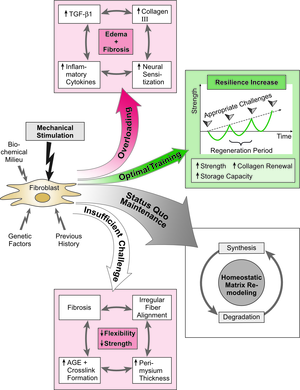Davis's law
Davis's Law[edit]

Davis's Law is a principle in anatomy and physiology that describes how soft tissues, such as muscles, tendons, and ligaments, adapt to the mechanical demands placed upon them. This law is named after Henry Gassett Davis, an American orthopedic surgeon who first described the phenomenon in the 19th century.
Principle[edit]
Davis's Law states that soft tissues will remodel and adapt in response to the mechanical stresses they experience. When tissues are subjected to increased stress, they will become stronger and more resilient. Conversely, if the stress is reduced, the tissues will become weaker and less dense. This principle is similar to Wolff's Law, which applies to bones.
Mechanism[edit]
The adaptation of soft tissues according to Davis's Law involves several biological processes:
- Collagen Synthesis: Increased mechanical stress stimulates the production of collagen, a primary structural protein in connective tissues.
- Cellular Response: Fibroblasts and other cells in the tissue respond to mechanical signals by altering their activity, leading to changes in tissue structure and function.
- Matrix Remodeling: The extracellular matrix undergoes remodeling to accommodate the new mechanical demands, enhancing the tissue's ability to withstand stress.
Applications[edit]
Davis's Law has important implications in various fields, including:
- Physical therapy: Understanding how tissues adapt to stress is crucial for designing effective rehabilitation programs.
- Sports medicine: Athletes use principles derived from Davis's Law to optimize training regimens and prevent injuries.
- Orthopedics: Surgeons and clinicians apply this knowledge to improve outcomes in surgical procedures and recovery.
Limitations[edit]
While Davis's Law provides a useful framework for understanding tissue adaptation, it is important to recognize its limitations:
- Individual Variability: The rate and extent of tissue adaptation can vary significantly between individuals.
- Overuse Injuries: Excessive stress can lead to overuse injuries, where tissues are damaged faster than they can adapt.
Related Pages[edit]
Ad. Transform your life with W8MD's Budget GLP-1 injections from $75


W8MD offers a medical weight loss program to lose weight in Philadelphia. Our physician-supervised medical weight loss provides:
- Weight loss injections in NYC (generic and brand names):
- Zepbound / Mounjaro, Wegovy / Ozempic, Saxenda
- Most insurances accepted or discounted self-pay rates. We will obtain insurance prior authorizations if needed.
- Generic GLP1 weight loss injections from $75 for the starting dose.
- Also offer prescription weight loss medications including Phentermine, Qsymia, Diethylpropion, Contrave etc.
NYC weight loss doctor appointmentsNYC weight loss doctor appointments
Start your NYC weight loss journey today at our NYC medical weight loss and Philadelphia medical weight loss clinics.
- Call 718-946-5500 to lose weight in NYC or for medical weight loss in Philadelphia 215-676-2334.
- Tags:NYC medical weight loss, Philadelphia lose weight Zepbound NYC, Budget GLP1 weight loss injections, Wegovy Philadelphia, Wegovy NYC, Philadelphia medical weight loss, Brookly weight loss and Wegovy NYC
|
WikiMD's Wellness Encyclopedia |
| Let Food Be Thy Medicine Medicine Thy Food - Hippocrates |
Medical Disclaimer: WikiMD is not a substitute for professional medical advice. The information on WikiMD is provided as an information resource only, may be incorrect, outdated or misleading, and is not to be used or relied on for any diagnostic or treatment purposes. Please consult your health care provider before making any healthcare decisions or for guidance about a specific medical condition. WikiMD expressly disclaims responsibility, and shall have no liability, for any damages, loss, injury, or liability whatsoever suffered as a result of your reliance on the information contained in this site. By visiting this site you agree to the foregoing terms and conditions, which may from time to time be changed or supplemented by WikiMD. If you do not agree to the foregoing terms and conditions, you should not enter or use this site. See full disclaimer.
Credits:Most images are courtesy of Wikimedia commons, and templates, categories Wikipedia, licensed under CC BY SA or similar.
Translate this page: - East Asian
中文,
日本,
한국어,
South Asian
हिन्दी,
தமிழ்,
తెలుగు,
Urdu,
ಕನ್ನಡ,
Southeast Asian
Indonesian,
Vietnamese,
Thai,
မြန်မာဘာသာ,
বাংলা
European
español,
Deutsch,
français,
Greek,
português do Brasil,
polski,
română,
русский,
Nederlands,
norsk,
svenska,
suomi,
Italian
Middle Eastern & African
عربى,
Turkish,
Persian,
Hebrew,
Afrikaans,
isiZulu,
Kiswahili,
Other
Bulgarian,
Hungarian,
Czech,
Swedish,
മലയാളം,
मराठी,
ਪੰਜਾਬੀ,
ગુજરાતી,
Portuguese,
Ukrainian